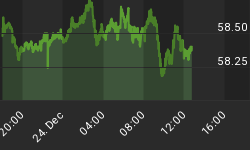I've had business relationship with American Home Mortgage (AHM), and I know people who used to work there. It's disheartening to see AHM employees leave their local branch offices carrying their personal belongings in boxes. About 7,000 AHM jobs have been cut. And, that wasn't the first or the only time I've seen mortgage lenders shutting down their operations. As bad as it is now, it may have only just begun.
I mentioned in my previous chartmentary that half of all American private sector jobs created since 2001 have been in housing related industries (see my Jan. 1, 2006 The Year of Charting Dangerously article). The lower than anticipated 92,000 new job number released on Friday was perhaps just the tip of the iceberg. A great number of people working in housing related industries as contractors, loan officers, and real estate agents, etc. are self-employed. They don't have any claim on unemployment benefits once they leave their jobs. Most of them perhaps have never been accounted for as unemployed.
Lately, Wall Street and financial media's focuses have been on earnings, credit problems, and oil price. They've either downplayed or ignored recent job reports. The market, nevertheless, has been taking heed of the fundamental change of the employment condition. And the change is simply too ominous, and too important, to ignore.
Chart 1 shows the number of jobs created rose convincingly from the February-March 2001 bottom to the March-April 2004 top, which coincides with the period of housing market boom. This number leveled off in April 2004 and began to decline in September-October 2005. Readers with keen observation may have noticed that Chart 1 also shows payroll number in the 2nd quarter of 2000 stumbled below the 100,000 earmark and then proceeded to plunge into the negative territory. We all know what happened to the stock market then; it formed a major, multi-year, market top in March-April 2000.

Chart 1
In any event, as a confirmation, the membership of one of the major real estate Multiple Listing Services (MLS) in the San Francisco Bay Area also moved in synchronicity with the payroll trend (see Chart 2). The 12-month Rate of Change (ROC) began its major downtrend after the peak in 2004. This downtrend indicates fewer people coming into real estate business since the 2004 peak. It subsequently fell below zero in October 2006, but it bounced right back after spending just one month in the negative area. In February 2007, the membership number again dropped below the red zero neutral line. This time, however, it's been staying in the negative territory since.
Coincidentally, February 2007 also had the creation of only 90,000 jobs, the lowest in more than 2 years (see red circle on Chart 1 above).

Chart 2
And, the market told us, through one of its most proficient translators (a.k.a. the TRIN Index), that it had taken notice of this significant statistical event took place in February (see Chart 3).
Firstly, here's why the 200-day moving average was used on this chart. On 9/26/2006, the S&P 500 Index finally closed above the 5/8/2006 intraday high of 1326.70 and went on to break the all time intraday record in July 2007. On 7/16/2007, the S&P reached the record intraday high of 1555.90, which broke the previous intraday high of 1553.11 in 2000 (March 20). Interestingly, from the 9/27/2006 breakout date to the 7/16/2007 record breaking day, there were exactly 200 trading sessions. We'll then use 200-day moving average for this analysis.
The blue arrow on Chart 3 shows that this 200-day moving average of the TRIN Index had at last moved above the previous resistance (blue horizontal line) in February 2007, about the same time the non-farm payroll number hit a new low and the MLS membership dipped below zero again. Since the TRIN is derived from dividing the ratio of advancing and declining issues into the ratio of up and down volumes, this rising quotient over a long period, such as 200 days of running average, indicates the advancing issues that had helped buoy the price level to new high hadn't been proportionately supported by the buying volume.

Chart 3
And this lack of volume support is clearly demonstrated by the divergence of the PVO (Percentage Volume Oscillator) on this weekly S&P 500 Index chart (Chart 4). Both periods of rising price (blue lines) were countered by falling PVO (red lines). You might've also noticed on this chart that the recent selloff, unfortunately, was coupled simultaneously with a big surge of the PVO. This positive correlation indicates current selloff is for real; the selloff has been fully supported and highly participated by investors.

Chart 4
All technical divergences will have to be resolved sooner or later. That's what the market's doing right now. And, all fundamental divergences, too, will have to be resolved. A thriving stock market requires the convergence of a sound economy and a strong housing market. But that's not happening right now.
A strong housing market, as I've made my case repeatedly in the past, requires most importantly solid employment growth. Everything else like interest rates etc. is just secondary. The development of the declining employment condition is now taking on a dangerous, self-reinforcing quality.
As the housing market continues to decay, more workers from the related industries will be let go. And, because of the magnitude of this workforce, their discharges will not only increase the unemployment rate, but it will also reduce the sources of employment. This will in turn put even more pressure on the housing market, the stock market, and ultimately the economy. And, by all means, a weakening economy will further reduce employment opportunities. The problem may have already started feeding on itself.
If there's a light at the end of the tunnel, I haven't seen it yet.
















